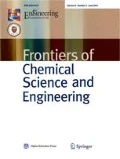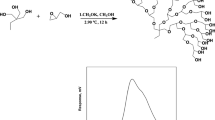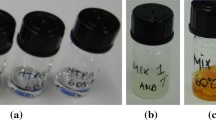Abstract
Basing on hydroxyl terminated hyperbranched poly(amine-ester)s (HPAEs), the cross-linking reactions and preparation of ester-crosslinked HPAE films were investigated using succine anhydride (SA) as crosslink reagent. It was proved that the cross-linking reaction between HPAE and SA followed a two-step mechanism. This mechanism provides an efficient route to prepare HPAE/SA cross-linked films, in which, the precursor films were prepared by casting HPAE/SA solution at a lower temperature, and then curing the films at a higher temperature. By varying SA content, the solid HPAE/SA films with different cross-linking degrees were prepared successfully. The highest tensile strength of the cross-linked film could reach 59.60 MPa. With all water contact angle smaller than 74.3°, the crosslinked films demonstrated good hydrophilic properties.
Similar content being viewed by others
References
Kim Y H, Webster O W. Hyperbranched polyphenylenes. Macromolecules, 1992, 25(21): 5,561–5,572
Kim Y H. Hyperbranched polymers ten years after. J Polym Sci, Part A: Polym Chem, 1998, 36: 1,685–1,698
Jikei M, Kakimoto M A. Hyperbranched polymers: A promising new class of materials. Prog Polym Sci, 2001, 26: 1,233–1,285
Inoue K. Functional dendrimers, hyperbranched and star polymers. Prog Polym Sci, 2000, 25: 453–571
Hong X Y, Chen Q D, Zhang Y M, Liu G R. Synthesis and characterization of a hyperbranched polyol with long flexible chains and its application in catonic UV vuring. J Appl Polym Sci, 2000, 77(6): 1,353–1,356
Xie S H, Zhu B K, Wei X Z, Xu Z K, Xu Y Y. Dendrimer templates and their applications in preparation of nanoparticles. Journal of Functional Materials, 2003, 34(5): 488–490 (in Chinese)
Wei X Z, Zhu B K, Xie S H, Xu Y Y. Templatation and stabilization of amino-terminated poly (amido-amine) dendrimer in formation of copper nanoparticles. Journal of Functional Materials, 2005, 36(8): 1,242–1,244 (in Chinese)
Kang S H, Luo J D. A hyperbranched aromatic fluoropolyester for photonic applications. Macromolecules, 2003, 36: 4,355–4,359
Hong L, Shi L Y. Conductivities and spectroscopic studies of polymer electrolytes based on linear polyurethane and hybrid and copolymer of linear and hyperbranched polyurethanes. Macromolecules, 2003, 36: 4,989–4,994
Fang J H, Kita H, Okamoto K. Gas permeation properties of hyperbranched polyimide membranes. J Membr Sci, 2001, 182: 245–256
Xu M, Tan K, Zhou H J, Yan X H, Yu X H. Effect of terminal groups on the properties of hyperbranched polymers. Journal of Functional Polymers, 2003, 16(3): 299–303 (in Chinese)
Zhang S W, Jiao H Y, Liu G T, Wang S J, Hou W L, Ba X W. Functional reaction of the terminal hydroxyl groups on the AB2 type hyperbranched poly(amine-ester) with acetic oxide. Journal of Functional Polymers, 2002, 15(3): 286–290 (in Chinese)
Pandey A K, Goswami A, Sen D, Mazumder S, Childs R F. Formation and characterization of highly cross-linked anion-exchange membranes. J Membr Sci, 2003, 217: 117–130
Shao L, Chung T S, Goh S H, Pramoda K P. Tansport properties of cross-linked polymide membranes induced by different generations of diaminobutane (DBA) dendrimers. J Membr Sci, 2004, 238: 153–163
Lu Y, Lin D, Wei H Y, Shi W F. Synthesis and characterization of hyperbranched poly (amine-ester). Acta Polymerica Sinica, 2000, (4): 411–414 (in Chinese)
Kou H G, Shi W F. Study of photopolymerization characteristics of hyperbranched methacrylated poly(amine-ester)s. Acta Polymerica Sinica, 2000, (5): 554–558 (in Chinese)
Wei X Z, Zhu B K, Xiao L, Xu Y Y, Geckeler K E. Novel cross-linked films prepared from hyperbranched poly (amine-ester). Macromol Rapid Commun, 2005, 26: 1,224–1,227
Cai R Z, Li L, Jiang Y L. The determination of hydroxyl value with acetic anhydride acetone method. Journal of Zhengzhou Institute of Technology, 1992, 13(4): 92–94 (in Chinese)
Wang L Z, Zhang J T, Lin J. Synthesis of dibutylmaleate using p-toluene sulphonic acid as a catalyst. Chinese Journal of Synthetic Chemistry, 2000, 8(6): 553–555 (in Chinese)
Author information
Authors and Affiliations
Corresponding author
Additional information
__________
Translated from Journal of East University of Science and Technology (Natural Science Edition), 2006, 32(10): 1,164–1,168 [译自: 华东理工大学学报 (自然科学版)]
Rights and permissions
About this article
Cite this article
Xiao, L., Wei, X. & Zhu, B. Reaction and characterization of crosslinking hyperbranched poly(amine-ester) with succine anhydride. Front. Chem. Eng. China 1, 355–359 (2007). https://doi.org/10.1007/s11705-007-0064-y
Issue Date:
DOI: https://doi.org/10.1007/s11705-007-0064-y




